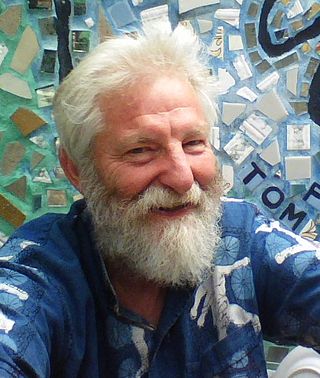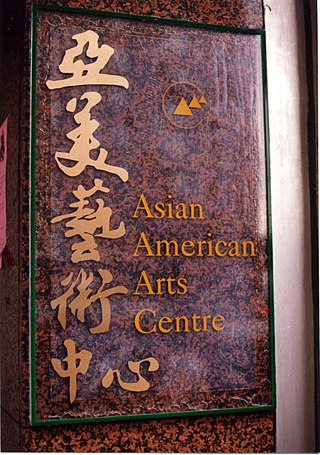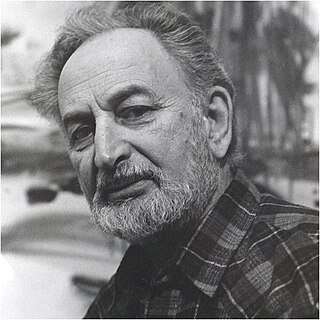An art centre or arts center is distinct from an art gallery or art museum. An arts centre is a functional community centre with a specific remit to encourage arts practice and to provide facilities such as theatre space, gallery space, venues for musical performance, workshop areas, educational facilities, technical equipment, etc.
Mural Arts Philadelphia is a non-profit organization that supports the creation of public murals in Philadelphia, Pennsylvania. Founded in 1986 as the Mural Arts Program, the organization was renamed in 2016. Having ushered more than 4,000 murals into being, it calls itself "the nation’s largest public art program." As of 2024, the organization runs 50 to 100 public art projects each year, including new murals in neighborhoods such as Kensington, Northern Liberties, and the Gayborhood. It also works to maintain existing murals.

The Chinese Culture Center of San Francisco is a community-based, non-profit organization established in 1965 as the operations center of the Chinese Culture Foundation located in Hilton San Francisco Financial District, at 750 Kearny Street, 3rd Floor, San Francisco, California, United States.
Lenny Seidman is a tabla player, a composer, a co-director of the Spoken Hand Percussion Orchestra, and a World Music/Jazz curator at the Painted Bride Art Center in Philadelphia.

Isaiah Zagar is an American mosaic artist based in Philadelphia. He is notable for his murals, primarily in or around Philadelphia's South Street.

Kearny Street Workshop (KSW) in San Francisco, California, is the oldest multidisciplinary arts nonprofit addressing Asian Pacific American issues. The organization's mission is to produce and present art that enriches and empowers Asian Pacific American communities. Notable participants include author and Asian American studies scholar Russell Leong, playwright and author Jessica Hagedorn, author Janice Mirikitani, poet and historian Al Robles, and actor and filmmaker Lane Nishikawa.

The Asian American Arts Centre (AAAC) is a non-profit organization located in the Chinatown neighborhood of Manhattan in New York City. Founded in 1974, it's one of the earliest Asian American community organizations in the United States. The Arts Centre presents the ongoing developments between contemporary Asian & Asian American art forms and Western art forms through the presentation of performance, exhibitions, and public education. AAAC's permanent collection, which it has accumulated since 1989, contains hundreds of contemporary Asian American art works and traditional/folk art pieces. The organization also has an Artists Archive which documents, preserves, and promotes the presence of Asian American visual culture in the United States since 1945. This includes the East Coast, especially the greater New York area; the West Coast; and some artists in Canada, Hawaii, and overseas. The artists include Asian Americans producing art, Asian artists who are active in the United States, and other Americans who are significantly influenced by Asia. Pan-Asian in outlook, the Arts Centre's understanding of 'Asia' encompasses traditions and influences with sources ranging from Afghanistan to Hawaii.
An alternative exhibition space is a space other than a traditional commercial venue used for the public exhibition of artwork. Often comprising a place converted from another use, such as a store front, warehouse, or factory loft, it is then made into a display or performance space for use by an individual or group of artists. According to art advisor Allan Schwartzman "alternative spaces were the center of American artistic life in the '70s."

The Painted Bride Art Center, sometimes referred to informally as The Bride, is a non-profit artist-centered performance space and gallery particularly oriented to presenting the work of local Philadelphia artists, which presents dance, jazz, world, folk and electronic music, visual arts, theatre and performance art, poetry and spoken word performances.
Nina Kuo is an Asian American painter, photographer, sculptor, author, video artist and activist who lives and works in New York City. Her work examines the role of women, feminism and identity in Asian-American art. Kuo has worked in partnership with the artist Lorin Roser. Kuo has been described as being a pioneer of AAPI and Chinese American art and culture.
Tomie Arai is a public American artist, printmaker, and community activist living and working in New York City. Her works consist of temporary and permanent multimedia site-specific art pieces that deal with topics of gender, community, and racial identity, and are influenced by her Japanese heritage and the urban experience of living in New York. She is highly involved in community discourse, co-founding the Chinatown Art Brigade. Her work is nationally exhibited and can be found in the collections of the Library of Congress, the Bronx Museum of the Arts, the Japanese American National Museum, the Williams College Museum of Art, the Museum of Modern Art, and the Whitney Museum.
Kay Ulanday Barrett is a published poet, performer, educator, food writer, cultural strategist, and transgender, gender non-conforming, and disability advocate based in New York and New Jersey, whose work has been showcased nationally and internationally. Their second book, More Than Organs received a 2021 Stonewall Honor Book Award by the American Library Association and is a 2021 Lambda Literary Award for Transgender Literature Finalist. They are a 2020 James Baldwin Fellowship recipient, three-time Pushcart Prize Nominee, and two-time Best of the Net Nominee. Barrett's writing and performance centers on the experience of queer, transgender, people of color, mixed race people, Asian, and Filipino/a/x community. The focus of their artistic work navigates multiple systems of oppression in the context of the U.S.
Ginger Brooks Takahashi is an American artist based in Brooklyn, New York, and North Braddock, Pennsylvania. A self-identified “punk,” Takahashi grew up in Oregon. She co-founded the feminist genderqueer collective and journal LTTR and the Mobilivre project, a touring exhibition and library. Takahashi was also a member of the band MEN. Her work consists of a collaborative project-based practice, and one of her most notable works is An Army of Lovers Cannot Fail (2004–2013), a series of quilting forums.
Erica Cho is a bi-coastal visual artist, animator, and filmmaker. They are Assistant Professor of Narrative Media in the Department of Visual Arts at the University of California, San Diego, and were previously a visiting assistant professor at Swarthmore College in the Film and Media Studies department. Cho has acted as a film curator for the Los Angeles Asian Pacific Film Festival since 2011, and organized and founded the first Tri-Co Film Festival in 2012. They have received the Creative Capital Moving Image Award, among other awards.

Moe Albert Brooker was an African American painter, educator and printmaker. An abstract artist, he used vivid colors, lines, stripes, squares and circles to infuse a feeling of improvisational jazz in his works. Brooker was an internationally known artist whose paintings are in the collections of major museums and other institutions.
Basement Workshop emerged as the first Asian-American political and arts organization in New York City, in existence from 1970 to 1986. Created during the Asian American Movement, it became an umbrella organization for a diverse group of young Asian-Americans seeking creative and new ways of intersecting artistic expression with political and community activism. The rise of the Black Power Movement and protests against the Vietnam War provided a partial yet weighty backdrop for Basement’s inception.

Jaishri Abichandani is a Brooklyn-based artist and curator. Her interdisciplinary practice focuses on the intersection of art, feminism, and social practice. Abichandani was the founder of the South Asian Women's Creative Collective, with chapters in New York City and London, and director from 1997 until 2013. She was also the Founding Director of Public Events and Projects from at the Queens Museum from 2003 to 2006.
Ka-Man Tse is a Hong Kong-born photographer, video artist, and educator based in New York. Influenced by her Asian-American and queer identity, Tse primarily uses portraiture to tell stories about the people, identity, visibility, and place in and around the queer community.

Hugh Mesibov was an American abstract expressionist artist who began his career as a federal artist for the Works Progress Administration during the Great Depression and later became a member of the 10th Street galleries and part of the New York School during the 1940s-60s. His work has elements of the mid-20th-century New York artistic experience such as Surrealist and Abstract Expressionist and figurative aspects across several media such as watercolor, oil, and acrylic as well as etchings, lithographs and monoprints. His work has received a global reputation and is included in many collections in the United States and worldwide.

Arden Bendler Browning is an American visual artist based in Philadelphia. While primarily known for her paintings, Bendler Browning's work spans various media, including works on paper, paintings incorporating digital technologies such as virtual reality and animation, and standalone virtual reality applications. She has also completed several public art projects.








